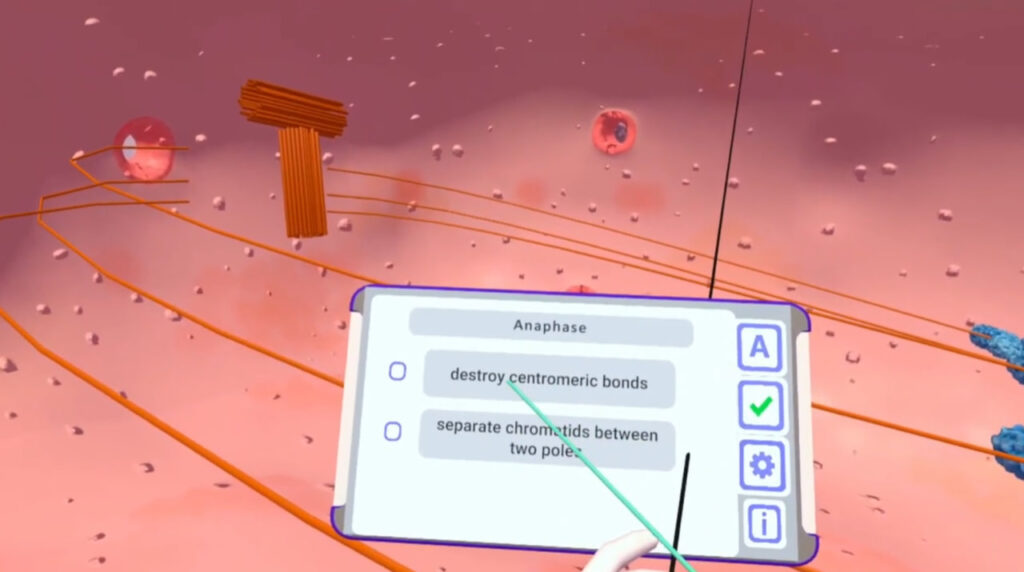

Mitosis stands as one of the most intricate and challenging topics in high school biology curricula. This complexity stems from two primary factors:
The process of mitosis is a cornerstone of biology education, essential for understanding cell division, growth, and reproduction. However, its complexity often leaves students struggling to fully comprehend and retain the information.
Typically, biology teachers rely on static images or microscope slides to illustrate the stages of mitosis. However, this method has significant drawbacks:
Experienced educators consistently report that students face considerable difficulties mastering this crucial biological concept using conventional teaching methods. This is where innovative vr education apps and vr education software can make a significant difference.
As a leading VR education company, XReady Lab has developed a groundbreaking VR Mitosis simulation that transforms this challenging topic into an engaging, interactive experience. Our VR education services leverage cutting-edge technology to create immersive learning environments that address the question: “How can VR be used in education?”

Here’s how VR is used in education to enhance the learning of mitosis:
Active Participation Instead of passively viewing static images, students become active participants in the mitotic process. They perform key actions such as replicating DNA, forming the mitotic spindle, aligning chromosomes, etc.
This hands-on approach turns a theoretical concept into a practical lesson, addressing the need for secondary school experiment ideas that engage students more effectively.
Motor Memory Enhancement Our simulation leverages motor memory to reinforce learning. Rather than simple clicks, students perform actions that mimic actual cellular processes. For example:
This approach creates a stronger connection between the concept and the physical action, aiding in long-term retention and providing practical reasons for learners to participate in the lesson.
Safe Experimentation and Exploration VR provides a safe environment for students to conduct a school experiment without the risks or limitations of a physical lab. As they progress through each stage, students receive a checklist of upcoming events, encouraging independent exploration of cellular structures.

This checklist serves as a science lesson plan template, guiding students through the process while allowing for self-paced learning.
Personalized Learning Experience Each student independently performs all events within the simulation. This personal involvement allows them to recount the process in their own words: “I doubled the DNA.” “I broke down the nuclear envelope.” “I moved the chromosomes to the center.”
This first-person narrative reinforces understanding and helps students internalize the complex sequence of mitotic events, transforming a theoretical science lesson plan into an immersive, memorable experience.
XReady Lab’s VR Mitosis simulation offers numerous advantages over traditional teaching methods:
Incorporating XReady Lab’s VR Mitosis simulation into your science lesson plan is straightforward and can significantly enhance your teaching effectiveness. Here’s how you can integrate this tool into your biology curriculum:
Early adopters of XReady Lab’s VR Mitosis simulation report significant improvements in student engagement and comprehension. Teachers observe:
These improvements demonstrate the power of VR education games in transforming abstract concepts into engaging, memorable learning experiences.
While our Mitosis simulation is a flagship product, XReady Lab is committed to developing a comprehensive suite of vr education apps for biology and other sciences. Other simulations include:
By expanding our offerings, we aim to revolutionize how students engage with complex biological concepts across the curriculum.
We invite you to explore the future of science education with XReady Lab’s VR Mitosis simulation. Visit our demo request page to access our free VR education apps and discover how they can revolutionize the way your students learn biology.
Don’t just explain mitosis — let your students experience it firsthand. With XReady Lab’s VR simulations, you’re not just teaching biology; you’re inspiring the next generation of scientists, researchers, and innovators.
As we continue to push the boundaries of educational technology, VR stands out as a transformative tool for teaching complex scientific concepts. XReady Lab’s VR Mitosis simulation is just the beginning of a new era in biology education – one where students don’t just learn about cellular processes, but experience them firsthand.
By incorporating our VR simulations into your curriculum, you’re not only enhancing your science lesson plans but also equipping your students with the skills and understanding they need to excel in an increasingly technological world.
Don’t let your students miss out on this revolutionary learning experience. Embrace the future of biology education with XReady Lab’s VR simulations and watch as your students’ understanding and enthusiasm for science soar to new heights.
Frequently Asked
We prodive VR biology, VR physics, and VR chemistry simulations. Please, check our catalog.
Please, fill the form to get demo labs for free.
Please contact our customer support service at support@xreadylab.com or book a call with the team to find out the conditions and book the VR class set up at your school.
Subscription to XReady Lab interactive VR labs. If you are a school, then you are also given access to the VR classroom system. VR class system helps you easily launch VR lessons for a large number of students, follow the experience of each student, as well as customise the content without developers.
We adhere to the world’s generally accepted recommendations and research. Our products are suitable for children from 12 years old.